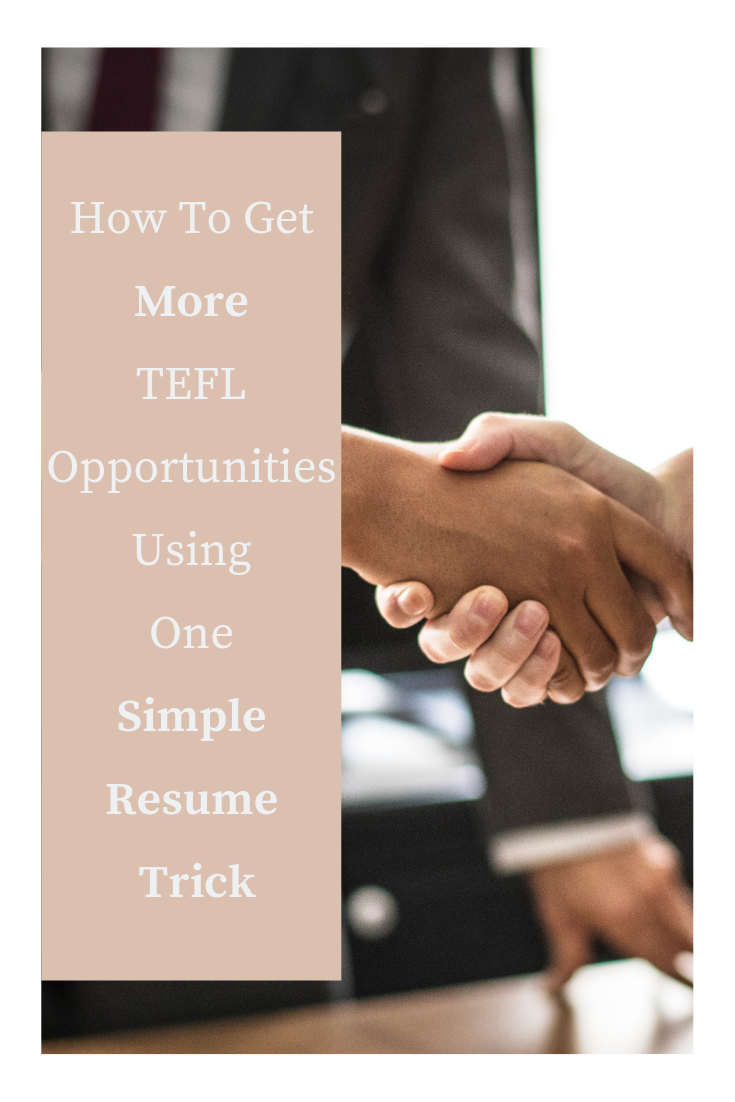How To Get More TEFL Opportunities Using One Simple Resume Trick
Resumes are a minefield to navigate. Writing a good resume takes summary skills, writing skills, and an ability to capture your audience.
I suck at writing resumes mostly because I’m an academic writer. I like to write long, thoughtful paragraphs backed by evidence to support my claims.
That kind of writing doesn’t resonate with hiring managers whatsoever.
Once I finally got a chance to sit in the other seat - that of the one hiring - I understood why very qualified candidates often failed to impress prospective employers.
It was simple: applicants weren’t looking at their resume from the perspective of the employer.
Let’s take a look at what this actually means.
If you’re applying to ESL jobs then you should take advantage of things that still work in your favor.
For example, most ESL employers still sift through resume applications manually, which means you get to choose how your information is presented.
Even better is you don’t have to worry about trying to beat some algorithm looking for keywords on your resume. Yet.
If you want to get more ESL job opportunities, you have to change the experience an employer has when they read your resume.
If you’re like most people, you probably wrote your first resume while in some sort of high school or college class on how to do life.
You might have tweaked and changed the resume over the years, but it still has the same basic skeleton. And with it, the same tired feeling.
Keep in mind that corporate employers typically see around 250 resumes per job. Even if we only took 25% of that number, that’s still over 60 resumes that some poor soul has to get through.
A typical, uninspiring resume starts with your name, contact information, objective, education, then work history.
Yawn.
It’s your job to disrupt the recruiter’s mundane routine and beckon him or her like a heavenly slice of chocolate cake after a glorious meal.
Think about your audience. What does the person who has seen 60+ resumes want most?
A piece of cake damn it! Which means finding the best candidate as soon as possible.
And how do you capitalize on that?
You make your entire resume a document that serves the reader - not you. They don’t care about you yet, and why should they?
That person cares about finding out if you’re right for them. That’s it.
Don’t make their job any harder by hiding valuable information in bloated paragraphs about roles and responsibilities that don’t strengthen your application.
Instead, lay out what they’re looking for - in plain sight - and make the treasure hunt more pleasant.
Don’t stuff your resume with things that don’t pertain to the role you’re applying for.
Tempting as it might be to show that you’re an accomplished person, if your accomplishments have nothing to do with the job, and you can’t make the connection for the recruiter, leave it out.
If you’re someone who is new to ESL teaching either because you just graduated or you want to change careers, it’s important to highlight the qualities you bring as a teacher.
In other words, you’ll have to creatively extract information about your previous background and experiences to show your employer that you’re not only a capable person, but that you’re capable of teaching English language learners.
How To Design An ESL Resume That Resonates
I promised you that only thing needed to change about your resume to get more ESL job interviews and opportunities and I meant it.
There’s a quote by Swami Vivekananda that says “The truth can be stated in a thousand different ways, yet each one can be true.”
If we remove ‘The truth’ and replace it with “A resume’ the statement would be just as accurate.
If you looked at your resume now, would you say it’s very easy for a recruiter to see - in 5 seconds - what qualities or experiences make you qualified to be an ESL teacher in their school?
Would they, a) have to read through a bunch of your duties in previous jobs and make connections in their own minds about your capacity to teach?
Or, b) see a big neon sign that says “THIS IS WHY YOU SHOULD HIRE ME”?
If you’re reading this, you probably answered yes to question A, and that’s okay.
But I want you to take action.
To help you out a bit, I’ve created an example of what a winning resume looks like for someone who has no classroom experience and is coming from a different industry.
It’s a completely editable form that you can download below.
If you have any questions, ask them in the comments section.
What are some tricks you use to get recruiters to notice your resume? Comment below.
Was this article helpful? If so, please tell your friends about it and share!







